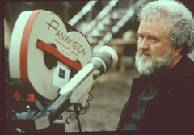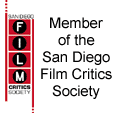|
|
||||
|
by Diana Saenger  Although filming an ambitious, action-packed movie with classic monsters might seem a bit daunting to most cinematographers, it never fazed Allen Daviau, the master cinematographer for Van Helsing. “It was a pleasure to work with producer Sam Mercer and writer/director Stephen Sommers. We all got along well,” said Daviau, who has five Oscar nominations for his outstanding work on Empire of the Sun, The Color Purple, E.T., Avalon and Bugsy. “I started shooting tests for Van Helsing in the fall of 2002.” Daviau faced many challenges on this film including finding and lighting massive sets, shooting on more than 70 locations in Color television first inspired Daviau to study photography. “I studied other photographers and films and started gate crashing when I was only 16,” he said. “I bought a 16 mm camera and began shooting, editing film and designing stage lighting for plays and opera. I worked with a lot of people, especially in TV, but I got my big break when I worked with Steven Spielberg on E.T.” In Van Helsing, Daviau enjoyed shooting both monsters and monster slayers. Are there any differences in lighting a hero versus a villain? “Basically lighting is lighting, but first you have to figure out what the mood is. One of my favorite shots in Van Helsing is between Dracula and Van Helsing in the basement of Dracula’s castle. It’s a low key, moody scene where they move through patches of light and a lot of shadow, and there’s a lot of mood.” Daviau incorporated some new technological resources in the filming. “We had a new film stock (5218) that we can marry to digital instead of going to a lab,” he explained. “So we could shoot on film, look at film dailies, then at the stage where you’re doing your digital intermediary you scan the film negatives at a high rate, 4K. Then you’re working with a digital projector and putting a big image on the screen so your seeing it at the approximate scale the film audience will see it. At the same time we have control not just of brightness and color, but contrast, areas of the frame and the texture is much more available to us. And it’s a delight for the cinematographer.” So it changed your whole medium? “It improved it. People ask if we shot it different. No, we shot and had film dailies every day, and if we had to, I think we would have released a heck of a good film just like in the past in a regular lab. But this extended our range and particularly for a picture like Van Helsing. There’s over 1200 special effects shots, and by having the capabilities offered by digital technology, it’s just tremendous.” How much of a film’s success can be credited to a cinematographer? “Of course, a cinematographer can make a real contribution to the film. At the start of the film I like to sit down with the director and its team to initially converse. But making a film is a collaborative effort. The costumes by Gabriella and Carlo are just fantastic. Allan Cameron, the production designer and the designer who did the Mummy movies, did some very special work to convert the church to a palace. We used a lot of high tech equipment in this picture, not all the time but we had an opportunity to try certain things, and Allan built this remarkable set, which you see in the Transylvanian village. It’s where Van Helsing first meets Count Dracula when he arrives in What was your favorite film to work on and why? “It’s hard to say, but I guess Steven Spielberg’s Empire of the Sun. It should have had more play but was one of the films that came out a time when the film industry didn’t love Steven, and we got wedged between Bertolucci’s The Last Emperor, and John Boorman’s Hope & Glory. Empire of The Sun still runs on TV and they just made a new high definition transfer of it last year.” Does it ever bother you that people walk out of the theater and barely know what a cinematographer is? “No. We are enjoying that more people are aware of the cinematographer. It’s been over ten years since we did Visions of Light, the story of cinematography and the people who wrote the book in the early days. It’s on DVD, and I highly recommended it.” But you must sense the great contribution you make to films such as Van Helsing? “Of course. It’s the kind of thing you are proud to do, because writer/ director Stephen Sommers has a tremendous sense of casting, the people in the film are so wonderful and he made a good scary movie, something that truly echoes the traditional horror genre, but at the same time makes you laugh. That’s one of the things that is so remarkable about him as a filmmaker.” Remarkable also describes Allen Daviau himself.
|
||
|
© 2025 - ReelTalk Movie Reviews Website designed by Dot Pitch Studios, LLC |




